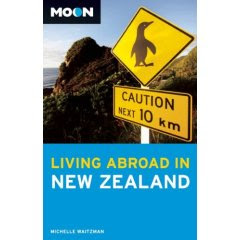 At the trail head
At the trail head
Christmas break seems to be the only time we get out for a longer than a weekend tramp these days. So this year we decided to tackle the longest of New Zealand's "Great Walks" - the Heaphy Track.
The track is 78.4 km long and can be walked in anything from 4-6 days. (I suppose you could do it in less, but only if you're going super-lightweight.) It's located in Kahurangi National Park, which occupies the north-west corner of the South Island. The track starts (or ends, as you can do it in either direction) around 30 km from Collingwood in Golden Bay, and ends close to Karamea on the West Coast.
We did a 5 day trip, mainly because that was the easiest way to arrange transportation to and from the trailhead. There is no way to do a car shuttle for the Heaphy, as the two ends of the trail are close to 500 km apart by road. So most trampers use some kind of commercial transport, and the most reasonable cost comes from taking a pre-scheduled service like we did. However, you can make arrangements for private transport if you have a specific schedule to keep - and if money is no object you can even get transported to the trail head by helicopter!
You can either stay in huts along the way, or camp at designated campsites (which are generally next to the huts.) We decided to camp as usually the huts are very busy over Christmas, and camping sounded a bit more peaceful. Unfortunately this meant that poor G was carrying our tent the whole way. All I had was the ground sheet. (I'm a bit spoiled!)
Two days before we started our tramp, there was a huge storm which hit the park - the worst in 150 years by some accounts. This caused major flooding and slips along the track, and washed away a couple of bridges. However, the water receded quickly and we were able to go ahead with our walk as planned.
The first day was where we encountered most of the new slips - around 10 of them. They were all crossable, but full of that thick, heavy mud that clings to your boots and makes that "schlorp" noise each time you take a step. It also made our boots super heavy as it clung to them in thick layers until we could find a stream to wash them off. This slowed our progress considerably, so instead of walking 5 hours on the first day (after a 4 hour drive to the trail head) we ended up walking almost 6.5 hours. Although the track was uphill all day, the grade is so gentle that you barely notice it. The track was originally explored as a possible road, so there is nothing tricky to negotiate - apart from the slips which I'm sure will be cleared up by DoC, after all this is a Great Walk.
 One of the new slips
One of the new slips
At the first hut (Perry Saddle Hut) we met the ranger, Mike. The rangers on the track have their own little huts they can stay in, and a certain range that they are supposed to look after. There were about half a dozen other campers, plus a full hut. Mike had found a brewing kit up at the rangers hut and had made a batch of beer up there, which he shared with the campers later that evening. While I'm not a beer drinker, it's certainly an unusual treat to get in the middle of the wilderness! The hut was located close to a river, where a few people decided to go have a wash. It must have been very cold, because we heard the kind of screams usually associated with horror movies!
 View from the campground at Perry Saddle
View from the campground at Perry Saddle
We also saw our first weka (a native, flightless bird) of the trip that first night, and they would appear at pretty much every campsite along the way, looking for a bit of free grub. One of the huts even had a sign on the door saying "Please shut the door when you leave, and please ensure the weka is not shut inside!"
 The wekas along the track are not shy!
The wekas along the track are not shy!The next day we moved out of the forest and onto the downs, which were mainly covered in red tussock.
 Tufts of red tussock
Tufts of red tussockWe encountered a pole where trampers leave their old boots, and a few other interesting items of footwear. When we passed by there was a pink stiletto and an inline skate tied to the pole.
 The boot pole
The boot pole
The next hut (Gouland Downs) was only a couple of hours down the track, and so we stopped for a short break there but carried on across the downs to Saxon Hut. This was a short day, just 3.5 hours of walking with no real hills to speak of. The track was well formed and graded the whole way. We had one slip to contend with at the beginning of the day, which was the only one we had to detour around rather than going across it.
Saxon Hut was in a lovely clearing, and the tent sites were on wooden platforms. They were nice and level, but hard and no matter how many tie-down spots they provide they never seem to be where you need them! Our spot was nice and sheltered on three sides though, which made for a pleasant night.
 Tent platform
Tent platformThe following day took us to James Mackay Hut, just three more hours down the track. We crossed a flat section that apparently can be impassable after heavy rain, but the storm of several days before had drained completely and the track was surprisingly dry.
Some small rivers had swing bridges, but could also just be forded if the water was low. We chose to use the bridges, because the novelty of having dry feet on a tramp in New Zealand was too much to pass up! The rivers were quite calm though, and could easily have been crossed. Most were dark with tannins, giving them a dramatic look.
 A tannin stained river
A tannin stained river Mini swingbridge over a stream
Mini swingbridge over a streamWe reached James Mackay Hut and found a tent platform slightly apart from the other ones for added privacy. However, it turned out to be the windiest spot and we had a bit of a challenge putting the tent up. We had the spot to ourselves until about 7pm, when a mother and daughter showed up and pitched beside us. They would have been nice, quiet neighbours except that the mother snored like a lumberjack all night! Not that it mattered, since it was New Year's Eve and several of the other campers were up celebrating noisily into the night. Thankfully we had ear plugs, as we didn't feel like partying with our longest day coming up.
Our fourth day we had to cover 20.5 km of track, around half of which was the descent back to sea level. However, the descent was as gentle as our climb on day 1 - so we hardly noticed it. Once we left the tops behind, the forest thickened and began to look more typical of the West Coast with mossy tree trunks, large ferns and tree ferns. We made our way down to Lewis Hut, which sits above the Lewis River. Apparently the hut had flooded quite badly the night of the storm, despite being around 5 metres above the normal level of the river! There were tons of sandflies around the hut, so after a quick toilet stop (I forgot to mention earlier that all of the toilets along the track are stocked with toilet paper - luxury!) we decided to continue on for a while and find a lunch spot on the track.
 Emerging from the forest at the coast
Emerging from the forest at the coastThe track followed the Heaphy River all of the way out to the coast, through lush forest full of ferns and Nikau palms - New Zealand's native palm tree.
 Nikau palm trees
Nikau palm trees
It was easy and pleasant walking, but still a long day. Heaphy Hut is place within view of the river mouth, as it meets the Tasman Sea. It's a very picturesque spot, with crashing waves and dramatic cliffs.
 The dramatic rivermouth
The dramatic rivermouth
The hut has a very manicured lawn, and a fairly large camping area off to one side. The camping area even has its own shelter, so you can cook under cover if it rains without using the hut facilities. The drawback of the location is an abundance of sandflies. The minute you stood still they would swarm around looking for a nice bit of exposed skin to bite. They had been present all along the track at each campsite, but here they were much more intense.
 Heaphy Hut with its manicured lawn
Heaphy Hut with its manicured lawn
Once we got our tent up, we went for a walk to escape the flies. We went down to the riverside, where a few people were going in to get a bit clean (I wouldn't go so far as to call it swimming - it was too cold for that) and we rounded the corner to the seashore and walked along the beach for a bit. It was out of the way of the flies, but the tide was coming in, and we didn't want to get cornered and have to scramble our way back to the campsite. So it was back to the bugs, and try to make dinner without becoming dinner!
We went back down to the beach later, but the wind must have dropped because the flies were now down there too. So there was nothing to do but escape into the tent and play cards for a while before turning in.
We got a pretty early start on our final day, not wanting to be late for our 1:30pm pick up. There is one spot along the coastal portion of the track which can be impassable when the tide is in and the seas are rough, and we were set to reach it right around high tide. The last leg of the track follows the coast straight south, mainly staying just off the beach at the edge of the forest. There are nikau palms everywhere! Even when you're not on the beach, much of the track is sandy and soft, which is a bit annoying to walk on.
There was a shelter and camping area around half way down, which was the least pleasant place I could imagine for camping. The ground was all uneven and covered in scrubby tall grasses, the sandflies were terrible and the outhouse was really close to where you would camp. Definitely for emergencies only!
We reached the spot where the track crosses the beach, and although we were right at high tide there was plenty of room as the seas were calm. We got there faster than expected, and slowed our pace so we wouldn't get to the trail head too early and have to wait around swatting flies for hours.
 Crossing a small stream along the coast
Crossing a small stream along the coast
Even taking our time, we were ahead of schedule and looked for some little rest stops where the flies weren't bad. Was another campground (much nicer than the earlier one) with picnic tables and fireplaces but still too many bugs to stay for long.
You cross a small saddle just before the end of the track, and on the top there is a little lookout area, which was thankfully bug free. We hung out there for a while chatting with other hikers, most of whom were on day walks. We also chatted with a German girl who was taking the same transportation as us, and also trying not to arrive too early.
When we reached the end, the bus was there early anyway so we needn't have worried.
The Heaphy Track (without the slips) is a very straightforward walk, and would be a good track for someone with limited experience or skills on more difficult terrain. It is long though, so you do need to be capable of walking up to 20 km in a day, carrying your gear and food. (On a six day version, the longest walk would be 17.5 km.) Both huts and campsites need to be booked in advance, and as this is a Great Walk the fees are higher than normal. Camping costs $12 per person per night. Huts cost something like $32 per person per night.
This winter, the track is scheduled to open to mountain bikers for the first time. This is a trial, with the track open for cycling in the winter season, and tramping in the summer. DoC will then assess whether the bikes are doing too much damage to the track. I'm sure it will have a noticeable effect on the surfaces, especially since the track is likely to be muddy over the winter, so bikes will create deep ruts. But we'll have to wait and see what happens with that.






































